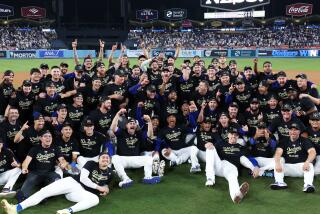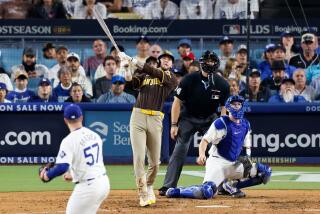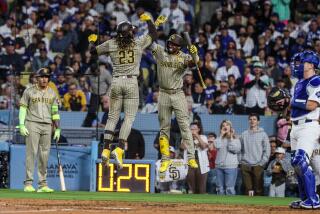Pitchers Love to Hit, but That Doesn’t Mean Hitting Loves Them
- Share via
Jack Clark discovered very early in his career that he had two attributes that would deny him a livelihood as a professional pitcher.
In his first game, he pitched reasonably well and got a couple of hits. In the next, he pitched poorly but got another hit. And then he pitched so poorly that the manager at the San Francisco Giants’ Great Falls farm club, Art Mazmanian, came out with the hook in the fifth inning.
“I’d batted once,” Clark recalled, “and gotten a hit. So he put me in the outfield. I got a couple more hits and a home run.”
That was it for Clark as a pitcher. Even if he could pitch, he had disqualified himself because . . . everyone knows pitchers cannot hit.
The irony is that pitchers love to hit.
“I don’t like the DH,” complained Ed Whitson, who has pitched in both leagues and had it both ways. “It takes part of the fun out of the game for pitchers.”
Mind you, Whitson has a .128 lifetime average as well as a rather succinct and realistic description of pitchers as hitters: “They stink.”
Obviously, the little matter of not being able to do something very well does not keep pitchers from fantasizing.
“I’ve never met a pitcher who didn’t think he could hit,” said Greg Booker, who proceeded to detail all of his major league hits . . . all five of them.
“I could do it,” said Eric Show. “I know I could.”
Mark Davis, the relief ace who hit a home run last year against the Giants, was sitting in front of his locker extolling the offensive virtues of the Padre starters when Bruce Hurst walked into the room.
“Wait a minute,” Davis said. “Remember what I told you about our starting pitchers being good hitters? Forget this guy. He’s not one of them.”
Of course, Hurst was ill-prepared for the National League’s traditional approach to baseball by his eight-year career with the Boston Red Sox. Pitchers hit in this league, even when they can’t.
“Really,” Hurst said, “I’ve never been a very good hitter. Not even in high school. Slow bat.”
At one point this spring, his teammates applauded a fair ball.
“Maybe,” he said, “I’ll get a hit by the end of the year.”
“And that,” said Dennis Rasmussen, “will get you a standing ovation in the dugout.”
A pitcher who can bat all of .200 is considered a good-hitting pitcher. That’s the term . . . good-hitting pitcher. Most pitchers get a hit about as often as they find $100 bills on the sidewalk.
“Every year I have a goal,” Davis said. “I don’t want to go 0 for the year. I don’t care if I have one at-bat or 18 at-bats. I haven’t had a 0-for-year yet, but I know one’s lurking out there for me.”
All of this chatter is interesting because Padre pitchers are collectively having a very good spring at the plate. They are seven for 24, or .292, unless Hurst is excluded. Then they are seven for 20, or .350.
Any spot in the batting order that produces either a .292 or a .350 average must be considered a very productive spot in the batting order, but this is obviously a bit of March madness.
Reality and .148 averages (Show, ‘88) set in Monday.
The problem, as pitchers see it through their Pete Rose-colored glasses, is that they could hit if anyone cared enough to give them an opportunity to practice. They make only cameo appearances in batting practice at home and almost none on the road.
“Our basic concern,” hitting coach Amos Otis said, “is to get the starting lineup all the hitting it can get. We only have so much time to hit and so many arms to throw batting practice.”
Show actually had one year, 1984, when he looked like a genuine hitter. He had three home runs and batted .246. He was, at the time, talking about acting in a movie about pitcher Christy Mathewson . . . but acting in real life like Babe Ruth.
“I was starting to put more time into hitting,” he said, “but then they started pitching me like a regular hitter.”
He has hit one home run since.
Walt Terrell, the newest Padre, once hit two home runs in one game against Chicago’s Ferguson Jenkins in Wrigley Field.
“There was a 40 mile-per-hour wind blowing straight in,” he said, “and I have the tapes to prove it.”
So Terrell must consider himself a pretty good hitter.
“We like to talk about how we could hit,” he said, “just like hitters like to talk about how they could pitch. None of us can hit worth a damn, and none of them could pitch worth a damn.”
Essentially, pitchers find hitting enticing, like a forbidden fruit.
“It’s something we don’t get to do,” Mark Davis said. “Look at the outfielders playing catch before a game. They’re all throwing knuckleballs and curveballs, because that’s something they don’t get to do. Actually, Carmelo Martinez has pretty good stuff.”
But there’s no way Carmelo Martinez can pitch. After all, he can hit.
Jack Clark would be the first to tell him that being able to hit is a killer for a young pitcher.
More to Read
Go beyond the scoreboard
Get the latest on L.A.'s teams in the daily Sports Report newsletter.
You may occasionally receive promotional content from the Los Angeles Times.










